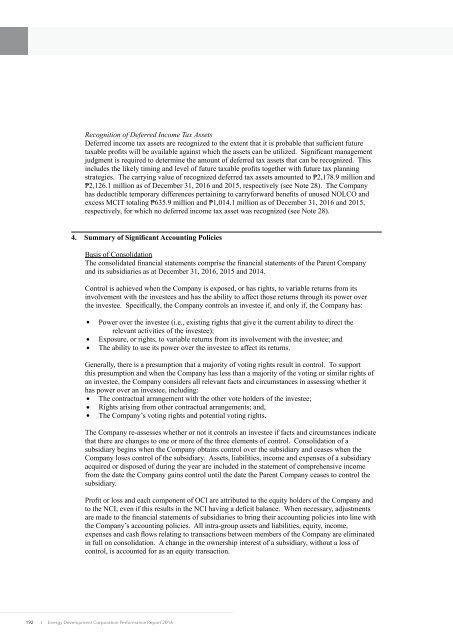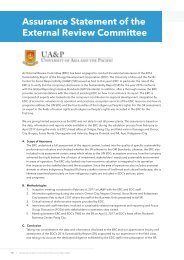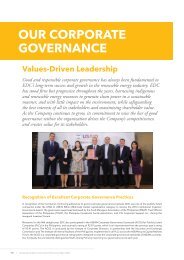EDC PR 2016 (FS section)
Create successful ePaper yourself
Turn your PDF publications into a flip-book with our unique Google optimized e-Paper software.
Recognition of Deferred Income Tax Assets<br />
Deferred income tax assets are recognized to the extent that it is probable that sufficient future<br />
taxable profits will be available against which the assets can be utilized. Significant management<br />
judgment is required to determine the amount of deferred tax assets that can be recognized. This<br />
includes the likely timing and level of future taxable profits together with future tax planning<br />
strategies. The carrying value of recognized deferred tax assets amounted to ₱2,178.9 million and<br />
₱2,126.1 million as of December 31, <strong>2016</strong> and 2015, respectively (see Note 28). The Company<br />
has deductible temporary differences pertaining to carryforward benefits of unused NOLCO and<br />
excess MCIT totaling ₱635.9 million and ₱1,014.1 million as of December 31, <strong>2016</strong> and 2015,<br />
respectively, for which no deferred income tax asset was recognized (see Note 28).<br />
4. Summary of Significant Accounting Policies<br />
Basis of Consolidation<br />
The consolidated financial statements comprise the financial statements of the Parent Company<br />
and its subsidiaries as at December 31, <strong>2016</strong>, 2015 and 2014.<br />
Control is achieved when the Company is exposed, or has rights, to variable returns from its<br />
involvement with the investees and has the ability to affect those returns through its power over<br />
the investee. Specifically, the Company controls an investee if, and only if, the Company has:<br />
Power over the investee (i.e., existing rights that give it the current ability to direct the<br />
relevant activities of the investee);<br />
Exposure, or rights, to variable returns from its involvement with the investee; and<br />
The ability to use its power over the investee to affect its returns.<br />
Generally, there is a presumption that a majority of voting rights result in control. To support<br />
this presumption and when the Company has less than a majority of the voting or similar rights of<br />
an investee, the Company considers all relevant facts and circumstances in assessing whether it<br />
has power over an investee, including:<br />
The contractual arrangement with the other vote holders of the investee;<br />
Rights arising from other contractual arrangements; and,<br />
The Company’s voting rights and potential voting rights.<br />
The Company re-assesses whether or not it controls an investee if facts and circumstances indicate<br />
that there are changes to one or more of the three elements of control. Consolidation of a<br />
subsidiary begins when the Company obtains control over the subsidiary and ceases when the<br />
Company loses control of the subsidiary. Assets, liabilities, income and expenses of a subsidiary<br />
acquired or disposed of during the year are included in the statement of comprehensive income<br />
from the date the Company gains control until the date the Parent Company ceases to control the<br />
subsidiary.<br />
Profit or loss and each component of OCI are attributed to the equity holders of the Company and<br />
to the NCI, even if this results in the NCI having a deficit balance. When necessary, adjustments<br />
are made to the financial statements of subsidiaries to bring their accounting policies into line with<br />
the Company’s accounting policies. All intra-group assets and liabilities, equity, income,<br />
expenses and cash flows relating to transactions between members of the Company are eliminated<br />
in full on consolidation. A change in the ownership interest of a subsidiary, without a loss of<br />
control, is accounted for as an equity transaction.<br />
192<br />
I Energy Development Corporation Performance Report <strong>2016</strong>
















